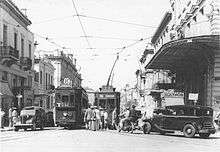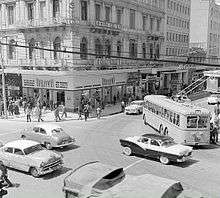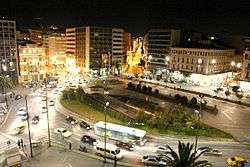Omonoia Square
| Omonoia Square | |
|---|---|
| Πλατεία Ομονοίας | |
 | |
 Omonoia in Athens | |
| General information | |
| Type | Open square |
| Architectural style | Neoclassicism |
| Town or city | Athens |
| Country | Greece |
| Design and construction | |
| Architect | Stamatios Kleanthis, Eduard Schaubert, Leo von Klenze |
Omonoia Square (Greek: Πλατεία Ομονοίας, Plateía Omonoías, pronounced [plaˈtia omoˈnias], "Concord Square", often simply referred to as Omónia [oˈmonia]) is a central square in Athens. It marks the northern corner of the downtown area defined by the city plans of the 19th century, and is one of the city's principal traffic hubs. It is served by Omonoia train station.
Omonoia Square is one of the oldest squares in the city of Athens and an important shopping centre. It is located at the center of the city at the intersection of six main streets: Panepistimiou, Stadiou, Athinas, Peiraios, Agiou Konstantinou and 3rd Septemvriou.
Name
The Square was constructed in 1846 and its original name was “Plateia Anaktoron” (Palace Square) because, according to the initial urban plan of Athens in 1834(1833;) proposed by the architects Stamatios Kleanthis and Eduard Schaubert, the area was intended to be used for the construction of the palace (anaktora). Later, the square was renamed “Othonos Square” in honor of King Otto. After Otto was deposed, in 1862 it took its final name, “Omonoia Square”, because it was here that the leaders of the opposing political factions gave the oath of peace (omonia) to stop hostilities.
History of design changes
At the end of the 19th century the Square underwent several formative changes. Trees were placed throughout the Square, a polygonal platform was placed at the center of the square and lighting systems were installed. Omonoia Square was a center where people met and social life thrived as it was the railway’s starting point ,and was also surrounded by numerous hotels.
From 1925 to 1930 the underground railway between Piraeus and Athens was built requiring further redesign of the Square. Omonoia Square became circular and marble bars are put at the entrances of the underground railway station. The Square started to resemble European prototypes and acquired an important commercial role. Due to the existence of the underground railway it was necessary to create also an underground ventilation system and in 1931 Mayor of Athens Spiros Merkouris suggested placing eight sculptures representing the mythological Muses to cover the openings of the ventilation vents. Although the problem was solved, the result did not satisfy Athenians’ aesthetic expectations and the statues were removed.
The 50s were a period of modernization for Athens and consequently for many public spaces. In 1954, in the underground area of Omonoia Square banks, shops and a post office were built.
In 1958 the Ministry of Transportation and Public Works held a competition for the development of Omonoia Square. Sculptor George Zongolopoulos and architect Kostas Bitsios were awarded the project. Their proposal included a circular water system in the middle of which would be placed Zongolopoulos’ sculpture “Poseidon”. The square was redesigned although in the end without the placement of the sculpture. The fountains of Omonia became a famous city landmark and the Square itself was depicted many times in Greek movies of the period.
Beneath the square lies the Omonia metro station, a major transport hub with passenger traffic equal to that of the Syntagma metro station.
Celebrations
Sporting celebrations have recently been held here, including following Greece's victory in the Eurobasket 2005 finals and in winning the championship. Other sporting successes, such as the Euro 2004 tournament, when people climbed the 'Five-ring' sculpture to celebrate with national flags, have also tended to be celebrated here.
Architecture
After its transformation in 2003 the square lost some of its former value and prestige, but nevertheless continues to represent a multicultural place and point of communication, as a transportation hub for thousands throughout the day. Two of its most recognizable buildings are the old neoclassical hotels of the area ; the "Bagkeion" and "Megas Alexandros", located side by side on either side of Athinas street. The Pentakiklon ('Five-ring' sculpture) has its own story ; placed in the square in 2001, it functioned fully during the Christmas of 2008, when water ran in the sculpture for the first time, transforming the circles into motion.
Gallery
- Two of the most recognizable buildings of the square: Bagkeion mansion (left) and Megas Alexandros Hotel (arch. Ernst Ziller)
 Omonoia Square, 1890
Omonoia Square, 1890 Omonoia Square, 1925
Omonoia Square, 1925 Omonoia during the 50's
Omonoia during the 50's Omonoia during the 60's
Omonoia during the 60's View of the square
View of the square Night view
Night view Omonoia Square, 2013
Omonoia Square, 2013
References
External links
| Wikimedia Commons has media related to Omonia. |
Coordinates: 37°59′03″N 23°43′40″E / 37.98417°N 23.72778°E